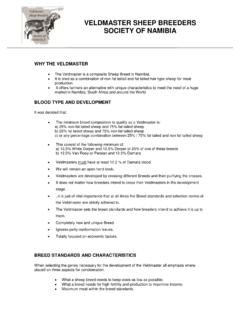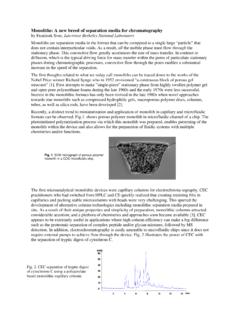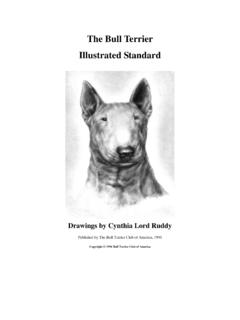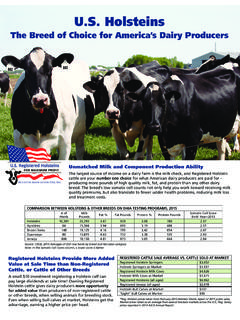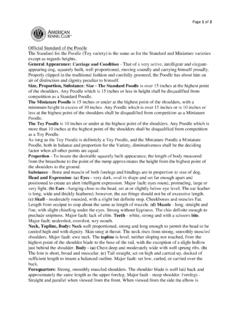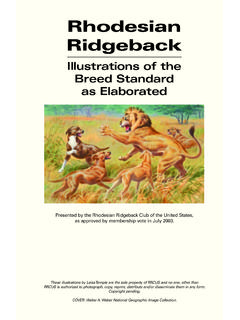Transcription of APA Large: Ameraucana Bantam
1 breed (with links to other sites with images and more information) Varieties / Rarity / What's a hen weigh? Class and Type Origins Egg color & productivity; egg size Comb Skin color Earlobes Brooding Hardiness Maturing Behavior Ameraucana FS PB club Black, Blue, Blue-wheaten, Brown-red, Buff, Silver, Wheaten, & White Easter Eggers are common. Standard Ameraucanas are rare. 80% / 12% (EEs/pure) Unchanged since 2003 Standard: kg Bantam : kg APA (1984): large : All Other Bantam : All Other Clean Legged PC: Not recognized Layer Fancy: Muffed, Bearded South American. May or may not be genetically related to the Araucana. One theory is that Ameraucanas were developed by crossing Aracaunas with other breeds. The more current, more accepted theory is that a different breed from Chile, the Quechua, was the parent stock from which the Ameraucanas were developed. Standardized & accepted into APA in 1984. Note: whatever name they use, most hatcheries do not sell standard Ameraucanas, but sell Easter Eggers -- chickens that may lay blue, green, or other colored eggs, but do not conform to standard.
2 Not a problem for backyard flocks. Various shades of blue & blue- green pea white with slate colored shanks red occasional brooder very cold hardy moderately early maturing well adaptable to confinement or free range; mostly calm, non-aggressive Our Birds [mostly mongrel Easter Eggers]: a few have been among the most curious & most easily handled birds we have owned. Others have been calm, non-aggressive, but stand-offish. None of ours has gone broody. We wouldn't have a flock without them. The chipmunky blue-egger. average to above average Ancona FS AL PP Black mottled, only Uncommon. 40% Unchanged since 2003 Standard: lb/2 kg Bantam : kg APA (1898): large : Mediterranean Bantam : Single Comb Clean Legged PC: Soft Feather Light Layer Developed in Italy in mid-19th century probably from leghorns sporting mottled feathers. Once rivaled the Leghorn in Europe, but never caught on in North America. white to light cream single, also rose yellow skin & shanks white non-setter generally hardy; very cold hardy except for combs early maturing hens prefers free range; nervous & restless in confinement; flyer; active, flighty, marked wildness, avoids human contact Almost a Leghorn, with black mottling.
3 Below average breed (with links to other sites with images and more information) Varieties / Rarity / What's a hen weigh? Class and Type Origins Egg color & productivity; egg size Comb Skin color Earlobes Brooding Hardiness Maturing Behavior Andalusian FS AL PP Blue (Black and Splash [White] used for breeding, but not recognized) Uncommon. Bird. 32% Unchanged since 2003 Standard: kg Bantam : kg APA (1874): large : Mediterranean Bantam : Single Comb Clean Legged PC: Light, Rare Layer Fancy: Blue feathered Developed in Spain & England in mid-19th century. Studied by Gregor Mendel in experiments in genetics & heredity. Blue color does not breed true. Black & Splash (White) are necessary for breeding. chalk to creamy white single white skin, slate blue shanks white mostly a non-setter Heat tolerant; combs subject to frostbite; ours were not robust, but that may not be representative of the breed . early maturing semi-adaptable to confinement, but prefers free range; active, flighty, noisy, avoids human contact Our Birds: ours, received as adults, never fit in well with the rest of the flock & were nervous all the time.
4 Our one cock crowed louder than any other we've ever had. We've been hesitant to try them again, but we might, since they are such beautiful birds. The original blue. above average Appenzeller or Appenzell FS PP club Spitzhauben (Pointed Hood) & Barthuhner (Bearded) Spitzhauben rare; Barthuhner practically unknown 8% /0% (spitz/barth) Unchanged since 2003 4 kg APA: Not recognized PC: Soft Feather Light Layer Fancy: Crested or Bearded Developed in Switzerland centuries ago. The name is thought to derive from the lace bonnets of the Appenzeller region. white horn, V-shaped, duplex white skin, blue shanks bluish white can be broody very cold hardy, except may have problems with freezing crest feathers early maturing not very tolerant of close confinement; flyer; active, flighty The national breed of Switzerland. average breed (with links to other sites with images and more information) Varieties / Rarity / What's a hen weigh? Class and Type Origins Egg color & productivity; egg size Comb Skin color Earlobes Brooding Hardiness Maturing Behavior Araucana or Rumpless Araucana FS PP PB club Black, White, Black Breasted Red, Blue, Buff, Silver Purebreds are very rare.
5 0% Unchanged since 2003 Standard: 5 kg Bantam : kg APA (1976): large : All Other Bantam : All Other Clean Legged PC: Light, Rare Layer Fancy: Rumpless Ear Tufts According to the latest theory, developed in Chile from a cross between the Collonca and the Queteros, two of several different blue egg-laying chicken breeds and introduced to North American in 1921. Likely that some "mongrelization" occurred before standardization. Standards differ from country to country, indicating that some different crosses and parent stock may have been involved in the development of the breed . Note: no large North American hatchery, that I am aware of, sells Araucanas. Instead, whatever name they use, they are selling Easter Eggers -- chickens that may lay blue, green, or other colored eggs. For true Aracaunas, try some of the smaller farms and breeders. blue only pea yellow skin, willow shanks red good, or frequent, brooder Cold hardy. Araucanas carry a "lethal gene" which causes one quarter of chicks to die in the shell.
6 Moderately early maturing well adaptable to confinement or free range; calm, non-aggressive The rumpless, tufted blue-egger. below average Aseel or Asil FS AL PP PB Black, White, Duckwing, Red Spangled, Pyle, others Very rare. 4% Unchanged since 2003 Standard: 5 kg Bantam : 2 kg APA: large : All Other PC: Hard Feather Heavy Game Developed in India more than 2000 years ago, perhaps even 3500 years ago. Thought to be the breed from which the Cornish was primarily developed. lightly tinted productive over short season small pea yellow skin & shanks red can be broody, protective mothers hardy, but not feathered for cold winters; very hardy in high heat slow to mature bears confinement better than most other game breeds; extremely fierce & pugnacious, but docile & easily handled when away from other cocks; because of aggressiveness, not recommended for a mixed flock Ancient Indian athlete. below average breed (with links to other sites with images and more information) Varieties / Rarity / What's a hen weigh?
7 Class and Type Origins Egg color & productivity; egg size Comb Skin color Earlobes Brooding Hardiness Maturing Behavior Australorp or Black Australorp FS AL PP club Black, only (standard); also blue & white Common 80% Down since 2003 Standard: kg Bantam : 2 kg APA (1929): large : English Bantam : Single Comb Clean Legged PC: Soft Feather Heavy Dual Purpose Developed in 20th century in Australia, primarily from the Orpington. Gained notoriety when one hen in the 1920s laid a record 364 eggs in 365 days. In earlier "contests," a team of six Australorps averaged eggs in a year. That individual performance has never been matched by subsequent Australorps. Not recommended if high egg production is your sole goal for getting chickens. brown single white skin, dark shanks red can be broody; good mother very hardy; very cold hardy moderately early maturing well adaptable to confinement or free range; calm, docile; more easily handled Our Birds: confession: we have both Black Orpingtons and Australorps, and I can't tell them apart.
8 They are docile, but haven't been close to what some call "friendly." The purported egg-laying champ from Oz average Barnevelder FS PP Double-laced, Blue-laced, White, Black, others Rare, but surging with new interest in dark egg layers. 12% Up since 2003 Standard: 6-7 kg Bantam : kg APA (2001): large : Continental PC: Soft Feather Heavy Dual Purpose Developed in late 19th century and early 20th century in Holland for dark egg laying. Developed from an older local variety that may date as early as the 12th century. In recent history, some strains have been bred for show and others for the darkness of their eggs. very dark reddish brown, with matte finish single yellow skin & shanks red mixed reports on setting & brooding less cold hardy; developed in region known for damp conditions slow to mature, & some chicks can be easily bullied well adaptable to confinement or free range; calm, docile Our Birds: ours fit in well with the flock, but shied away with human contact.
9 Ours laid reddish brown eggs, but most were not especially dark. None currently in our flock, we will likely try them again. Famous for large dark brown eggs. average to above average breed (with links to other sites with images and more information) Varieties / Rarity / What's a hen weigh? Class and Type Origins Egg color & productivity; egg size Comb Skin color Earlobes Brooding Hardiness Maturing Behavior Belgian D'Anver, or Antwerp Belgian, Barbu d'Anvers FS PP Quail, Porcelain, Black, Blue, Buff, Cuckoo, Mille Fleur, White, Mottled, and more Common 60% Up from 33% in 2003 True Bantam : kg APA (1949): Bantam : Rose Comb Clean Legged PC: True Bantam Bantam Bearded Developed in Anver region of Belgium many decades ago. Rumpless versions are called De Grubbe. breed is often referred to simply as the Quail Bantam , after the most popular variety. creamy white rose white skin, dark shanks white good, or frequent, brooder robust slow; some reports indicate chicks difficult to rear active, flyer; hens calm, cocks can be aggressive The bearded Bantam .
10 Tiny Belgian D'Uccle or Barbu d'Uccle FS PP club Mille Fleur, Porcelain, Black, Buff, White, Blue Mottled, Splash, Golden Neck, others Common 80% (mille fleur /porcelain) Mille Fleur down from 93% in 2003 True Bantam : kg APA (1914): Bantam : Feather Legged PC: True Bantam / Rare Bantam Bearded Feather Footed First bred in Uccle (Belgium) before 1900 by Michel Van Gelder. breed is often referred to simply as Mille Fleur, the most popular variety. creamy white small single with large spikes white skin & shanks white great brooder (or annoyingly too frequent brooder) hardy; because of fancy feathering, not suited for foul weather very slow to mature for full coloring tolerates confinement; fliers; calm, cocks less aggressive than other banties The bearded, booted Bantam tiny breed (with links to other sites with images and more information) Varieties / Rarity / What's a hen weigh? Class and Type Origins Egg color & productivity; egg size Comb Skin color Earlobes Brooding Hardiness Maturing Behavior Booted or Sabelpoot FS PP club Black, Blue, Buff, Mille Fleur, Porcelain, White, Mottled, others Very rare 0% Unchanged since 2003 True Bantam : kg APA: Bantam : Feather Legged PC: True Bantam , Rare Bantam Feather Footed One of the more ancient bantams; developed in the Netherlands.
